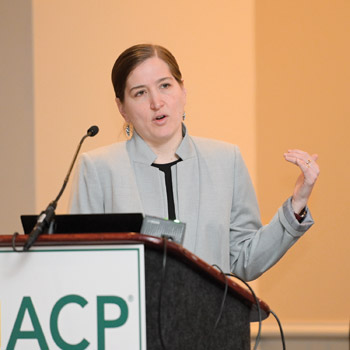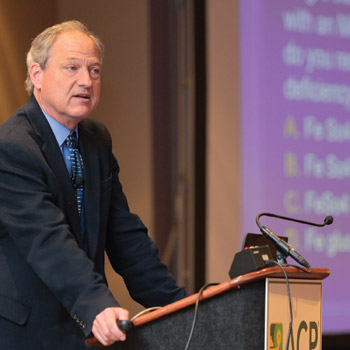
Palliative care's place outside cancer
Integrated palliative care is important in offering comfort measures to patients with conditions that are expected to shorten their life spans.
Imagine a firefighter rushing toward a burning house and being stopped by a neighbor.
“The house is on fire!” says the fireman.
“I worry that if you go in there, it might send the wrong message to the family,” says the neighbor.
“But I'm with the fire department,” the fireman responds.
“If you tell the family that, they might lose all hope,” says the neighbor.

That's how interactions between hospitalists and primary care doctors and palliative care consultants sometimes go, said Rebecca N. Hutchinson, MD, FACP. She played a comic video including a version of the previous exchange to the audience at her talk, “Palliative Care in the Noncancer Inpatient,” to illustrate her point. The video, by Jared Rubenstein, MD, of Texas Children's Hospital, has made its rounds among the palliative care community, proclaiming, “Palliative care. We're the fire department, not the fire.”
Ideally, palliative care should be integrated into treatment, Dr. Hutchinson said. “It's really just good, patient-centered care, and it's beneficial throughout the disease trajectory.”
Palliate early
There's rarely a time when only disease-modifying therapy or only comfort measures are what's right for the patient. Having an integrated plan is best, she said. “You can do everything and palliate at the same time.”
One complication is that the trajectory of illnesses other than cancer may be much different than cancer's trajectory. Dr. Hutchinson described the latter as a horizontal line, with a strong sudden dip downward near the end of life.
Noncancer patients' trajectories may be more like a gentle swoop downward, but with sudden dips that represent repeated exacerbations or hospitalizations. The challenge is that physicians don't know which dip is the final one. In this trajectory, palliative care can help patients adjust to their chronic conditions and cope with a long-term illness as well as the uncertainty inherent in their disease trajectory, Dr. Hutchinson said.
Another key difference between cancer and noncancer palliative care is the continuation of disease-modifying treatments until the end of life. With cancer, chemotherapy ultimately becomes harmful instead of helpful and is eventually stopped, Dr. Hutchinson said, while, for example, in advanced heart failure and chronic obstructive pulmonary disease (COPD), diuretics and bronchodilators are consistent with comfort. “In heart failure and COPD, it is rare that stopping disease-modifying medications is actually helpful,” she said.
Another obstacle to providing palliative care is who delivers it. There is one palliative care specialist for every 1,200 patients with a serious illness in the U.S. Dr. Hutchinson compared that to the one cardiologist for every 71 patients with a myocardial infarction and one oncologist for every 141 cancer patients.
“The good news is while there aren't palliative care providers everywhere, all physicians can provide palliative care,” Dr. Hutchinson said. Internists and hospitalists already communicate with patients and families, control symptoms, coordinate care with subspecialists, and bring in psychological support.
Palliative specialists come into play when managing complex and refractory symptoms, including behavioral and psychological ones. They also can referee disputes between physicians, frame prognostic conversations, help patients and families understand the process, and cope with uncertainty in decision making, she said.
Prognostic conversations are a challenge, Dr. Hutchinson noted. “We have to accept a certain degree of prognostic uncertainty. Just because you're uncertain doesn't mean that you don't have a clue,” she said. Not being certain can lead physicians to shut down and not communicate anything to the patient about a disease. “And that's really not helpful to patients and families. You do have an idea, and it's our job to communicate that.”
Another wrinkle is physicians being overly optimistic about how much time a patient may have left, often overestimating by a factor of four to six. The longer the duration of the patient-physician relationship, the greater the overestimate.
“It's a statement of how much we as physicians really care about our patients,” she said. “We care about these people, and we don't want them to die.”
One clue to how much time a patient may have left is functional status. Dr. Hutchinson described a patient who said that a year ago, he was walking and driving. Over the course of a year, that was cut back to use of a cane, next a walker, and finally a wheelchair. That's a really bad prognostic sign, particularly the rate of change, she said.
Dr. Hutchinson offered as another prognostic sign the “surprise question”: Would you be surprised if this patient died in the next year?
“This is a question that you can add to your rounds,” she said. “You can have this conversation with your team. Engage in thinking about the person's prognosis.”
Tools for talking to patients
Dr. Hutchinson said that there will be patients or family members who say, “I only want the good news,” or “I'm not going to die.”
“It's really normal to be ambivalent about getting bad news and hearing a bad prognosis,” she said. “Normalizing that ambivalence is the best first step.”
Be explicit about it, and respond with a respectful statement, such as, “I hear you only want the good news. I really admire how optimistic you manage to be in the face of all these hospitalizations. That's really a strength of yours.”
Then, use motivational interviewing skills, she said. Ask the patient to list the pros and cons of only hearing good news.
Another tip is to explore when and how it might be possible to discuss prognosis or bad news. Dr. Hutchinson recommended saying, “OK, we've reflected [on] why you may or may not want to hear a prognosis. How can we have this conversation? What are ways that we could make it safe enough that we could?”
Solutions might involve bringing in family or an interdisciplinary support team, setting a later time to talk, or even limiting the discussion to a 10-minute block of time.
“You have to respect boundaries. If the patient doesn't want to have a conversation, you can't have a conversation,” said Dr. Hutchinson.
Another tool she uses to encourage patients to talk is the wish-worry-wonder cycle, saying, “I wish for a miracle. I worry that might not happen. I wonder what you might want if our fears are realized. Maybe we can think about a plan B.” Worry is the biggest component of this tool, because it shows concern for the patient and family and is a more gentle way of suggesting a different frame of reference.
“In all of these conversations, it's important to listen more than you talk. And recognize that many requests for information are actually statements of emotion,” she said. “If a patient asks, ‘Are you saying that there's nothing more that you can do?’, that sounds like a question. Really what the patient is saying is, ‘You just gave me bad news, and I'm taking it in.’”
Patients at that point are processing emotion and are not ready to take in information about their condition, so provide details later, Dr. Hutchinson said.
“If you get a sense from patients what function they are willing to accept, their critical abilities, what's a minimum quality of life for them, then use that to influence what treatments are good for them, helpful for patients, families, and providers,” she said. “‘You've shared with me what are your goals of treatment. Given that, let's do this.’ It's much nicer for patients and families than these menus of options where they don't really know the likely impact of what they're choosing.”
Pearls for consults
Dr. Hutchinson said she applies the same communication skills she uses with patients to communicate with other clinicians.
Mixed messages from members of the care team can anger patients more than any other aspect of end-of-life care. “We do people a disservice by giving patients different messages,” she said. “We have to find a way to come together and give one message.”
When working with other doctors, she makes a point of listening more than she talks and never arguing. “Respect that even though you may have a different perspective, you have to respect that they do know the patient really well and are coming from a place of really caring. Talk through what you see and what they see,” she said.
If a clinician is particularly unrealistic, “I just ask questions, like I would with a patient.” She might point out that a patient who was walking is now in a wheelchair and ask the other physician what he or she thinks that might mean for the patient's prognosis. “You may not change their mind in that moment, but a lot of time it sinks in,” Dr. Hutchinson said.
Finally, she said, acknowledge uncertainty. “You don't know that you're right, and they don't know that they're right.”



